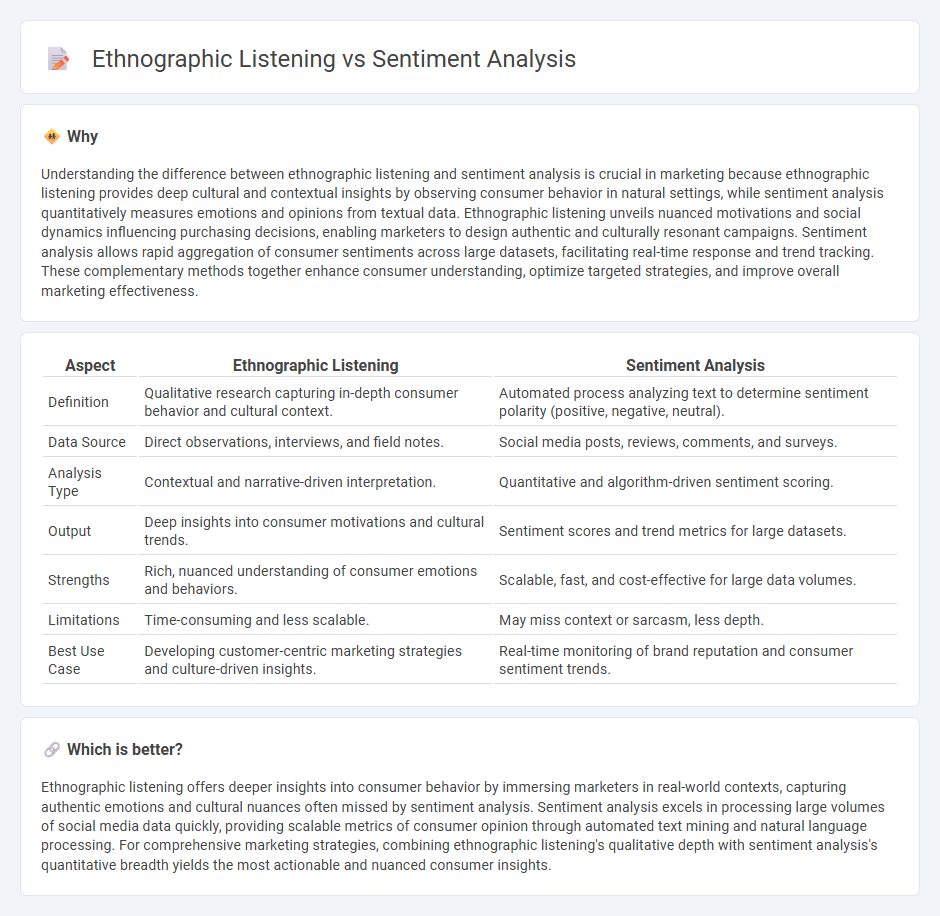
Ethnographic listening involves deeply understanding consumer behavior and cultural contexts through immersive observation and qualitative insights, revealing nuanced motivations behind purchasing decisions. Sentiment analysis utilizes natural language processing and machine learning algorithms to quantify emotions expressed in large volumes of text data, offering scalable, real-time feedback on brand perception. Explore how combining these approaches can enhance marketing strategies and customer engagement.
Why it is important
Understanding the difference between ethnographic listening and sentiment analysis is crucial in marketing because ethnographic listening provides deep cultural and contextual insights by observing consumer behavior in natural settings, while sentiment analysis quantitatively measures emotions and opinions from textual data. Ethnographic listening unveils nuanced motivations and social dynamics influencing purchasing decisions, enabling marketers to design authentic and culturally resonant campaigns. Sentiment analysis allows rapid aggregation of consumer sentiments across large datasets, facilitating real-time response and trend tracking. These complementary methods together enhance consumer understanding, optimize targeted strategies, and improve overall marketing effectiveness.
Comparison Table
| Aspect | Ethnographic Listening | Sentiment Analysis |
|---|---|---|
| Definition | Qualitative research capturing in-depth consumer behavior and cultural context. | Automated process analyzing text to determine sentiment polarity (positive, negative, neutral). |
| Data Source | Direct observations, interviews, and field notes. | Social media posts, reviews, comments, and surveys. |
| Analysis Type | Contextual and narrative-driven interpretation. | Quantitative and algorithm-driven sentiment scoring. |
| Output | Deep insights into consumer motivations and cultural trends. | Sentiment scores and trend metrics for large datasets. |
| Strengths | Rich, nuanced understanding of consumer emotions and behaviors. | Scalable, fast, and cost-effective for large data volumes. |
| Limitations | Time-consuming and less scalable. | May miss context or sarcasm, less depth. |
| Best Use Case | Developing customer-centric marketing strategies and culture-driven insights. | Real-time monitoring of brand reputation and consumer sentiment trends. |
Which is better?
Ethnographic listening offers deeper insights into consumer behavior by immersing marketers in real-world contexts, capturing authentic emotions and cultural nuances often missed by sentiment analysis. Sentiment analysis excels in processing large volumes of social media data quickly, providing scalable metrics of consumer opinion through automated text mining and natural language processing. For comprehensive marketing strategies, combining ethnographic listening's qualitative depth with sentiment analysis's quantitative breadth yields the most actionable and nuanced consumer insights.
Connection
Ethnographic listening involves immersing in consumer environments to capture authentic behaviors and cultural contexts, providing rich qualitative data. Sentiment analysis processes this data to quantitatively assess emotions and opinions behind consumer interactions, enabling marketers to interpret underlying attitudes. Combining ethnographic listening with sentiment analysis enhances the accuracy of consumer insights, driving more targeted marketing strategies and personalized brand communication.
Key Terms
Sentiment Analysis:
Sentiment analysis utilizes natural language processing and machine learning algorithms to automatically detect and quantify emotions within large volumes of text, providing scalable insights into customer opinions and market trends. This method excels in processing social media posts, reviews, and survey feedback to generate real-time data on emotional tone, enabling businesses to make data-driven decisions. Explore the advantages of sentiment analysis to harness emotional intelligence for your brand strategy.
Polarity
Sentiment analysis quantifies polarity in text by categorizing expressions as positive, negative, or neutral, leveraging natural language processing algorithms for large-scale data evaluation. Ethnographic listening emphasizes qualitative understanding of polarity within cultural and social contexts, capturing nuanced emotions and meanings through immersive observation. Explore deeper insights into how polarity is interpreted differently in these methodologies to enhance your analytical approach.
Natural Language Processing (NLP)
Sentiment analysis uses Natural Language Processing (NLP) algorithms to identify and categorize emotions within large text datasets, enabling businesses to quantify public opinion efficiently. Ethnographic listening, on the other hand, employs qualitative NLP techniques to deeply understand cultural contexts and nuanced human experiences through conversational data. Explore how combining sentiment analysis with ethnographic listening can enhance NLP-driven insights for more comprehensive audience understanding.
Source and External Links
What is Sentiment Analysis? | Definition from TechTarget - Sentiment analysis, or opinion mining, uses natural language processing (NLP) to identify and categorize the emotional tone of text as positive, negative, or neutral, helping organizations understand public opinion about products, services, or ideas.
Sentiment Analysis and How to Leverage It - Qualtrics - Sentiment analysis interprets qualitative data to gauge how people feel about a topic, with common types including fine-grained (measuring sentiment intensity), aspect-based (evaluating specific components), and intent-based (understanding the purpose behind the text).
What is Sentiment Analysis? - AWS - Businesses use sentiment analysis to determine the emotional tone of digital text (positive, negative, or neutral), employing approaches like fine-grained scoring, aspect-based, intent-based, and emotional detection for deeper customer insights.
 dowidth.com
dowidth.com